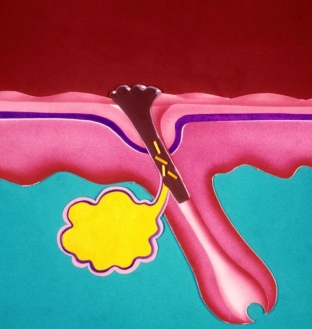Acne (acne) has long been a common problem not only in cosmetology, but also in dermatology and endocrinology. It manifests itself as a characteristic rash on the skin in certain areas of the body (primarily the face, shoulders, upper back and chest).
Acne is associated with a pathological process in the follicles of the sebaceous glands. The disease occurs only in humans (experimentally there have been attempts to recreate acne in rabbits, however, the development of colonization of Propionibacterium acnes in animals in this case was not observed). Acne is considered to be a polyetiological disease caused by both exogenous and endogenous factors.
Prevalence of acne
Although acne is often associated with adolescence and young age (according to statistics, it is among patients aged 12-25 in the Western Hemisphere that the prevalence of acne reaches 60-80%), certain manifestations of acne were also observed in children (including number in the neonatal period), as well as in persons of mature and elderly age. Acne affects both men and women to varying degrees.
The incidence of acne among adolescents and young adults reaches 60-80% in Western countries.
It is important to remember: Acne conglobata: symptoms and treatment of severe acne
Characterization of the main etiopathogenetic factors of acne
As mentioned above, acne is a polyetiological disease. The complex of factors influencing the development of acne include:
- overproduction of sebum;
- increased levels of androgens in the blood;
- bacteria (primarily strains of Propionibacterium acnes and Staphylococcus epidermidis;
- genetic predisposition;
- pathology of the interaction between the sebaceous glands and the surrounding connective tissue;
- nutritional factors (increased consumption of dairy and hyperglycemic products).
Increased secretion of the sebaceous glands (seborrhea) is one of the main prerequisites for the development of acne. The degree of seborrhea directly correlates with the severity of acne. So, an increased indicator of sebum secretion is considered to be secretion of 3.0 and more mg/cm2 of sebum for 3 hours. But still, hyperseborrhea is not a prerequisite for the occurrence of acne (in most patients suffering from parkinsonism, seborrhea is not accompanied by acne).
An increase in androgens stimulates both an increase in seborrhea and an increased proliferation of horny cells (corneocytes) at the top of the follicular canal of the sebaceous gland (acroinfundibulum). The secretion of androgens is most pronounced in adolescence. Eunuchs do not develop acne.
Hypersecretion of androgens – trigger factor in the pathogenesis of acne.
Bacterial contamination is usually very common accompanies acne. The main role in the development of inflammation and disruption of the process of keratinization with comedone formation belongs to the colonization of microaerophilic Propionibacterium acnes. The coagulase-negative Staphylococcus epdermidis, using sebum as a good nutrient medium, also plays an important role in the development of acne.
Currently, studies of the influence of genetic factors on the degree of development and severity of acne are ongoing. It has already been confirmed that the concordance in the rate of sebum production is more pronounced in identical twins than in fraternal twins. The hypothesis of a more severe course of acne in the presence of maternal history of acne is also considered.
An important role in the development of acne is also given to disturbances in the interaction between the products of the sebaceous glands and the receptor for the growth of connective tissue fibroblasts around them.
The degree of influence of nutritional factors on the occurrence of acne remains controversial. However, modern research has already confirmed that the consumption of cow's milk products and easily digestible carbohydrates leads to increased secretion of insulin and insulin-like growth factors 1 and 2, which further predisposes to increased acne formation.

Sequence of acne development and treatment tactics
The most recognized mechanism for the development of acne is:
- increased sebum production, onset of P. acnes colonization;
- formation of microcomedone due to increased production of horny cells and slowing down of desquamation processes;
- closed comedones formed due to regression of the sebaceous glands and the formation of caverns, positively affecting the growth of P. acnes;
- opening of comedones and severe clinical manifestations;
- late inflammatory process (may develop pustules, papules with further scarring).
Basic approaches to the treatment of acne:
- local lytic action on comedones;
- antiandrogen therapy (for female patients);
- antibacterial therapy (aimed at elimination of P. acnes colonization, less effective for S. epidermidis);
- local and systemic reduction of the inflammatory process (isotretinoin);
- diet with reduced dairy products and easily digestible carbohydrates;
- correction of concomitant endocrine diseases.
Use of antiandrogen therapy and systemic therapy with isotretinoin may be prescribed – according to indications - also for women, not only as a method of fighting acne, but also as a method of contraception.
You may be interested in: ABC of skin for a beautician. Structure of the epidermis







Add a comment